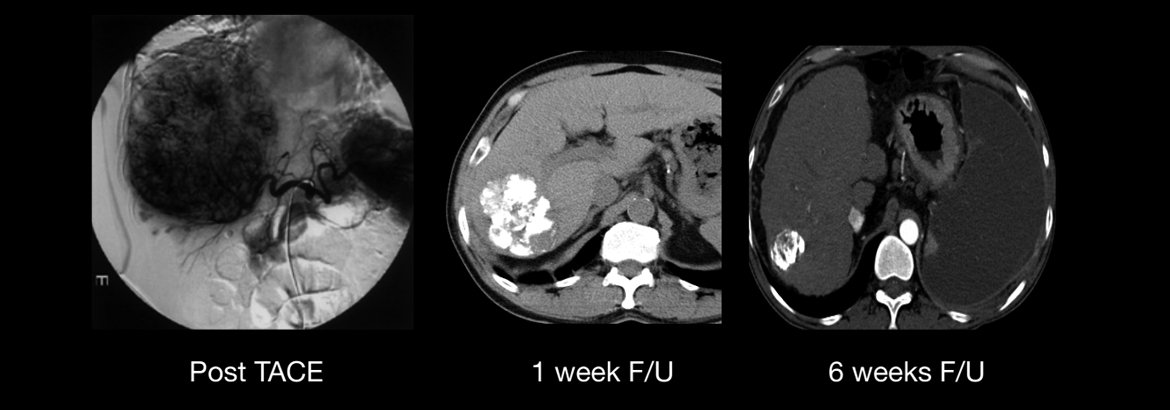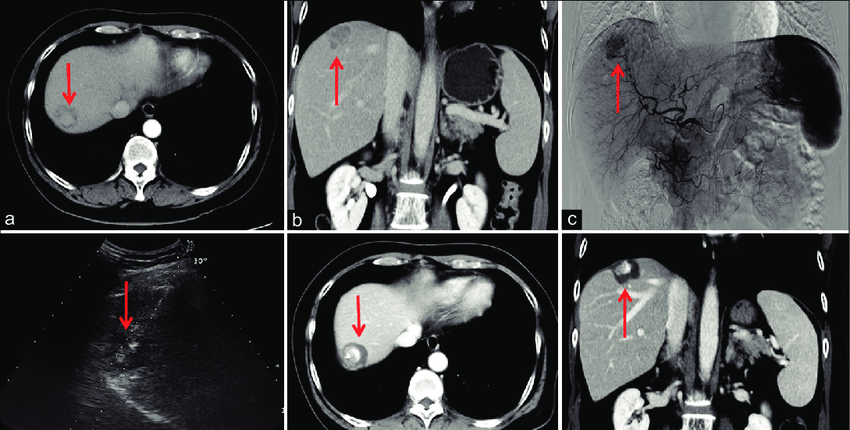Cancer
Dr. Amol Lahoti’s distinctive, minimally invasive, complete care procedures for oncology patients. Treatments are available at our state-of-the-art that includes both Diagnostic & Therapeutic Procedures.
TACE - for liver cancerTACE - for liver cancer
Transarterial Chemoembolization (TACE) is an essential component of interventional oncology, specifically used for treating liver cancer. It is part of a multidisciplinary approach to managing cancer, alongside medical, surgical, and radiation oncology. TACE is a minimally invasive procedure that delivers chemotherapy directly to the liver tumor while simultaneously blocking its blood supply, restricting the tumor’s growth. Image guidance techniques such as fluoroscopy, CT, or ultrasound (USG) are used to accurately target the liver tumor without harming nearby organs. This localized treatment approach minimizes systemic side effects.
TACE is typically used in patients whose liver cancer cannot be surgically removed or effectively treated with standard chemotherapy. Most patients undergoing TACE are treated as outpatients or may require just a brief hospital stay. The procedure is particularly beneficial for patients with multiple liver tumors, as it allows for regional treatment of affected areas. Additionally, TACE is often used in combination with other therapies as part of a comprehensive treatment plan led by the oncology team.

Microwave and Radiofrequency ablation for liver cancer
Microwave and Radiofrequency Ablation (RFA) are advanced interventional oncology techniques used to treat liver cancer. These minimally invasive procedures utilize image guidance, such as ultrasound or CT, to precisely target liver tumors while preserving healthy surrounding tissue. Both techniques use heat to destroy cancer cells: microwave ablation generates electromagnetic waves to create intense heat, while radiofrequency ablation uses electrical currents to produce localized thermal damage.
These treatments are typically recommended for patients whose liver cancer is inoperable or unsuitable for conventional surgery. Microwave and RFA are often performed on an outpatient basis, and patients usually experience quicker recovery times compared to traditional surgical options. These procedures are most effective for small tumors or when the cancer is localized, and they can be used alongside other treatments in a comprehensive cancer care plan.

Interventional Oncology
Interventional oncology is one of four pillars of a multidisciplinary team approach in treating cancer and cancer-related diseases. Medical, surgical, and radiation oncology are some of the other treatments available. Interventional oncology methods allow for a less intrusive diagnosis and treatment of cancer. Image guidance (fluoroscopy/ DSA, CT, or USG) is employed in conjunction with the most recent advances available to treat dangerous tumors to avoid any injury to other body organs. Most patients who have these procedures are outpatients or require a one-night stay in the hospital. Some of these cancer treatments are regional, covering multiple parts of the liver with chemoembolization or radioembolization. Other treatments, such as radiofrequency ablation (heating) to treat focal lesions in the kidney, liver, lung, and bone, are better known as local. Such procedures are often reserved for patients whose cancer cannot be surgically removed or effectively treated with systemic chemotherapy. They’re also regularly utilized in conjunction with other therapies that members of the oncology team have access to.


Why Choose Us?
Dr. Amol Lahoti is a certified interventional oncologist with extensive experience in endovascular treatment. He treated over 1000 patients, ranging from regular to complex, as well as some challenging ones. In order to provide his patients with more comprehensive care alternatives, he follows the most recent universal recommendations. Wish is his mantra, and he is still working hard to provide patients with what they need.
FAQ's
Frequently Asked Question
USG guided, and CT guided FNAC/Biopsies
Intra Arterial Procedures
Chemoembolization (TACE)
Radioembolization (TARE)
Pre-operative/ therapeutic embolization tumors
Percutaneous Tumor Ablation
Radiofrequency ablation (RFA)
Microwave ablation
- Paracentesis or Thoracentesis
- PICC line placement
- Port catheter placement
- Paracentesis or Thoracentesis
- Tunneled catheter placement
- Port catheter placement
- Percutaneous biliary drainage
- Percutaneous nephrostomy
- Stenting of malignant strictures: bile duct, esophageal, tracheobronchial, and intestinal
- PleurX catheter placement
- Embolization to achieve hemostasis.
- Pain management.
- Portal vein embolization
- Pain management.
